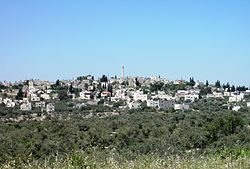Kifl Haris
| Kifl Haris | |
|---|---|
| Other transcription(s) | |
| • Arabic | كفل حارس |
| • Also spelled | Kifl Hares (official) Kefl Harith (unofficial) |

View of Kifl Hares, 2011
|
|
| Location of Kifl Haris within the Palestinian territories | |
| Coordinates: 32°07′07.02″N 35°09′25.02″E / 32.1186167°N 35.1569500°ECoordinates: 32°07′07.02″N 35°09′25.02″E / 32.1186167°N 35.1569500°E | |
| Palestine grid | 165/169 |
| Governorate | Salfit |
| Government | |
| • Type | Village council |
| • Head of Municipality | Ahmad Buziah |
| Population (2007) | |
| • Jurisdiction | 3,248 |
| Name meaning | "The village of the guard" |
Kifl Haris (Arabic: كفل حارس) is a Palestinian village in the northern West Bank, located six kilometers west of Salfit and 18 kilometers south of Nablus in the Salfit Governorate, northwest of the Israeli settlement city Ariel.
Sherds from the Middle Bronze Age, Iron Age II, Persian, Hellenistic, Roman, Byzantine/Umayyad, Crusader/Ayyubid and Mamluk eras have been found here.
In 1517, the village was incorporated into the Ottoman Empire with the rest of Palestine, and in 1596, Kafr Harit appeared in Ottoman tax registers as being in nahiya (subdistrict) of Jabal Qubal under the liwa' (district) of Nablus. It had a population of 54 households, all Muslim. They paid taxes on occasional revenues, goats and/or beehives, and a fixed amount. Sherds from the early Ottoman era have also been found.
In the late Ottoman period, in 1870, the French explorer Victor Guérin reached the village, after walking through "beautiful plantations of figs and olives". He estimated it had 600 inhabitants. The name of this place was given to Guérin as Kefil Haris. The Wely marked on the Palestine Exploration Fund 1880s map as Sheikh Ata, 1 mile north-east of Kefr Haris, is called by him Sheikh Khather. He also calls attention to the remains of an old watchtower built of large, well-cut stones, between Deir Estia and Kefr Haris. At the latter place he found two broken marble columns built up in the wall of the mosque.
...
Wikipedia

